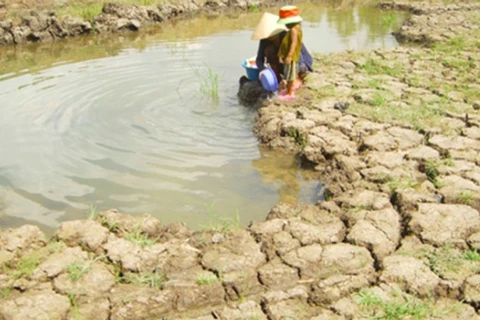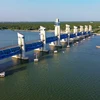An Giang (VNA) – The National Steering Committee on Natural Disaster Prevention and Control held a meeting on November 15 in Chau Doc city of An Giang province to evaluate its performance in response to floods in the Mekong Delta region.
Nguyen Hiep, deputy head of the Department of Natural Disaster Response and Mitigation under the Ministry of Agriculture and Rural Development’s Directorate for Natural Disaster and Control, said the peak of the flood season in the Mekong Delta this year reached alert level two for the first time in many years.
Floods in September this year, with water levels up to 3.8m, mostly affected Dong Thap, An Giang, Kien Giang and Long An provinces, inundating 1,845 hectares of rice, 5,480 houses, 2,375 hectares of fruit farms and 140.6 hectares of vegetables, while destroying 334m of roads. No deaths were reported.
However, a report by the National Steering Committee on Natural Disaster Prevention and Control showed that as the region has seen no serious floods for years, locals neglect preventive measures. Meanwhile, natural disaster forecasting is still inaccurate, rescue teams have yet to be equipped with adequate skills and there is a shortage of financial resources for evacuation missions.
Do Tien Lanh, Vice Director of the Vietnam Institute of Irrigation Science, in 2018, along with losses, floods benefited agriculture and aquaculture thanks to the alluvium it brought to fields.
However, the rapid withdrawal of flood waters at the end of the season may lead to early intrusion of saltwater, he said, advising localities to prepare for the dry season of 2019 when the Mekong River water level is forecast to be lower than the average level by 10-30 percent.
Flooding in the Mekong Delta region is predicted to be complicated next year.
However, Vice Director of the Directorate for Natural Disaster and Control Nguyen Truong Son stressed the need for better forecasts and alerts for the community.
Localities should direct the cultivation and harvest of rice crops to avoid floods, he said, adding they should allocate funds and mobilise social resources to reinforce dykes, while organising natural disaster prevention and control forces and strengthening communications among the community on preventive measures.
At the same time, regional localities should give proposals to Prime Minister Nguyen Xuan Phuc on the allocation of resources to implement projects of urgent prevention of erosion, construction of resilient residential areas for 11,366 households in An Giang, Dong Thap and Long An, with total estimated cost of more than 2.3 trillion VND.
Son also underscored the need to develop flood-based livelihoods and choose plants and domestic animal resilient to natural disasters and climate change.-VNA
VNA






















